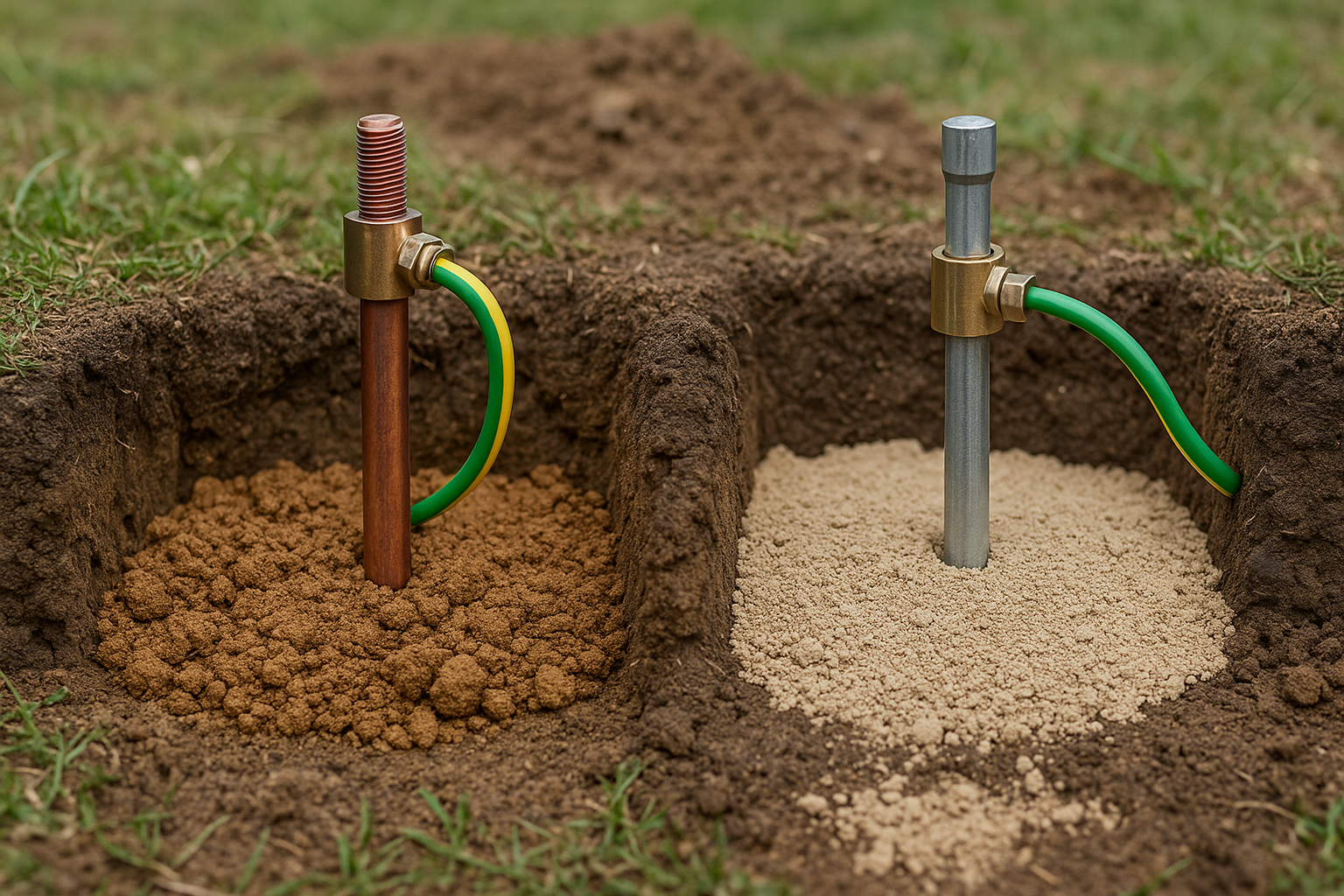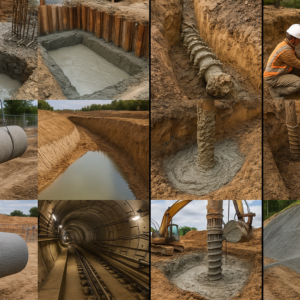When designing electrical grounding systems, choosing the right backfill material directly affects safety, performance, and long-term costs. Two popular options dominate the market: natural bentonite clay and chemical earthing compounds. Each offers different benefits depending on soil conditions, budget, and project requirements.
This guide compares earthing bentonite and chemical compounds to help you determine which solution works best for your grounding needs.
Understanding Earthing Materials and Their Purpose
Electrical earthing systems protect people and equipment by providing a safe path for fault currents. The material surrounding earth electrodes plays a key role in reducing soil resistance and maintaining consistent conductivity.
Backfill materials create better contact between electrodes and surrounding soil. They also help retain moisture, which directly impacts electrical conductivity. Without proper backfill, earth resistance can fluctuate with weather changes, compromising system performance.
What Is Earthing Bentonite?
Bentonite is a sodium-activated montmorillonite clay that swells to many times its dry volume when mixed with water. This natural material absorbs moisture from surrounding soil and retains it near earth electrodes.
The material comes in two main types: sodium bentonite offers high swelling capacity and excellent water absorption, while calcium bentonite exhibits lower swelling properties but maintains good absorption capability.
CMS Industries manufactures premium grades of bentonite specifically designed for earthing applications. Their sodium bentonite products provide superior moisture retention for grounding systems across varied soil conditions.
What Are Chemical Earthing Compounds?
Chemical earthing compounds are manufactured materials designed specifically for electrical grounding. These include products like Marconite, GEM (Ground Enhancement Material), and other conductive aggregates made from controlled mineral mixtures.
These materials work well in areas of poor conductivity, such as rocky ground, mountain tops, and sandy soil, where they can dramatically reduce earth resistance measurements.
How Does Bentonite Work for Earthing?
Bentonite absorbs up to five times its weight in water and swells to thirteen times its dry volume, creating a very dense, pasty clay condition at six times its dry volume that retains shape and adheres to surfaces.
This swelling property makes bentonite particularly effective as backfill material. When placed around earth rods or conductors, it creates a low-resistance zone that remains conductive even during dry seasons.
Key Properties of Earthing Bentonite
The compound typically achieves 3 ohms resistivity level and serves as a cost-efficient material for backfill of earth electrodes, performing well when it’s physically impossible to drive earth rods deeper under challenging ground conditions such as rocks and granite.
Bentonite also provides corrosion protection for buried conductors by creating a protective barrier between metal and aggressive soil elements.
How Do Chemical Earthing Compounds Work?
Chemical compounds function differently than bentonite. Marconite and similar materials contain conductive minerals that provide a permanent low-resistance path. These granulated conductive aggregates can replace conventional aggregate in concrete to provide a permanent medium with good electrical conductivity and high strength.
Depending on surrounding soil conditions, these materials can reduce electrode resistivity by up to 50 percent, conducting electricity through electron movement similar to metal.
Earthing Bentonite vs Chemical Earthing Compounds: Direct Comparison
Let’s break down the differences between these two backfill options across several factors.
Performance in Different Soil Types
Bentonite Performance:
- Excels in clay and loam soils with moderate moisture
- Works well where natural water table exists
- Requires periodic moisture to maintain effectiveness
- Suitable for temperate climates with regular rainfall
Chemical Compound Performance:
- Performs better in rocky, sandy, or arid conditions
- Maintains conductivity in dry climates
- Works in locations with minimal natural moisture
- Preferred for desert regions and mountain installations
Moisture Dependency
Bentonite relies on water absorption to function effectively. It absorbs moisture from surrounding soil, solving soil-to-earth-rod contact problems. This makes it less suitable for extremely dry environments without supplemental watering.
Chemical compounds show less moisture dependency. Marconite is maintenance-free and especially good for use in dry and arid conditions.
Structural Strength
Due to its clay-like nature, bentonite has limited strength levels. The material’s expansion when mixed with water makes it unsuitable for inclusion within building structures.
Chemical compounds offer structural benefits. Marconite concrete can achieve strengths higher than Grade 25 concrete and becomes touch-dry within hours, making it suitable for areas requiring both earthing and structural support.
Long-Term Stability
Bentonite can wash out in areas with heavy water flow or extreme drainage conditions. The material needs replenishment in some installations after several years.
Chemical compounds provide permanent solutions with no degradation over time. Once cured, they maintain conductivity indefinitely without maintenance.
Cost Considerations
Bentonite typically costs less than chemical compounds per kilogram. Installation expenses remain similar for both materials. CMS Industries offers competitive pricing on industrial-grade bentonite for earthing projects of all sizes.
Chemical compounds carry higher initial costs but eliminate long-term maintenance expenses, potentially offering better value over a system’s lifetime.
When to Choose Bentonite for Earthing
Select bentonite earthing compound when:
- Soil has adequate natural moisture: Areas with regular rainfall or high water tables
- Budget constraints exist: Projects requiring cost-effective immediate solutions
- Traditional grounding is sufficient: Standard installations without extreme environmental challenges
- Easy accessibility: Sites where future maintenance access is straightforward
- Temporary installations: Projects with shorter expected lifespans
Bentonite from CMS Industries provides reliable performance for these applications. Their ISO 9001:2015 certified manufacturing ensures consistent quality across all bentonite grades for earthing purposes.
When to Choose Chemical Earthing Compounds
Chemical compounds make better choices when:
- Dry or arid climates prevail: Desert regions, mountain peaks, or areas with minimal rainfall
- Rocky soil exists: Locations where conventional earth rods face installation challenges
- Structural integration needed: Sites requiring combined earthing and structural concrete
- Minimal maintenance access: Remote installations where future service visits are difficult
- Critical infrastructure: Telecommunications towers, data centers, or facilities requiring maximum reliability
- Space limitations: Areas where conventional electrode arrays cannot fit
Installation Considerations for Both Materials
Bentonite Installation Steps
- Drill or excavate the earth electrode location
- Place the electrode (rod, plate, or conductor)
- Mix bentonite with water according to manufacturer specifications
- Pour mixture around electrode, ensuring complete contact
- Backfill remaining space with excavated soil
- Water the area to activate bentonite swelling
- Test earth resistance after 24-48 hours
Chemical Compound Installation Steps
- Prepare electrode location through drilling or excavation
- Position earth electrode in place
- Mix chemical compound with water per product guidelines
- Pour material around electrode
- Allow curing time (varies by product)
- Complete backfilling
- Conduct resistance testing after full cure period
Environmental and Safety Factors
Bentonite is a naturally occurring mineral that poses no environmental hazards. It’s non-toxic and breaks down naturally over time. Handling requires no special protective equipment beyond standard site safety gear.
Chemical compounds vary in composition. Most manufactured products are chemically stable and environmentally safe once cured. Always review product safety data sheets and follow handling recommendations during installation.
Making the Right Choice for Your Project
Here is why understanding your specific requirements matters: soil resistivity, climate conditions, access limitations, and budget all influence material selection.
Start by conducting soil resistivity testing. This provides baseline data for comparing expected performance. Consult with grounding system designers who can calculate required electrode configurations with each material type.
For projects across moderate climates with reasonable soil moisture, bentonite offers excellent value. When environmental conditions present challenges or maintenance access is limited, chemical compounds justify their higher initial cost through superior long-term performance.
Real-World Applications
- Power Distribution: Utilities often use bentonite for substation grounding where soil conditions support it. Chemical compounds find use in remote tower locations.
- Telecommunications: Cell towers in rural or mountainous areas benefit from chemical compounds’ reliability in varying conditions.
- Industrial Facilities: Manufacturing plants with adequate moisture typically use bentonite for cost savings. Facilities in arid regions prefer chemical compounds.
- Residential Installations: Home earthing systems commonly employ bentonite due to lower costs and adequate performance in standard soil conditions.
Quality Matters in Earthing Materials
Regardless of which material you select, quality directly impacts system performance. CMS Industries manufactures bentonite products meeting international standards for earthing applications. Their strategic location near world-class ports ensures reliable supply for projects throughout India and export markets.
When sourcing chemical compounds, verify manufacturer specifications and request test data showing actual performance in conditions similar to your site.
Testing and Verification
After installation, proper testing confirms system effectiveness. Measure earth resistance using calibrated test equipment. Compare results against design specifications and local electrical codes.
Seasonal testing helps identify performance variations. Bentonite systems may show resistance changes between wet and dry seasons. Chemical compound installations typically maintain more consistent readings year-round.
Maintenance Requirements
Bentonite earthing systems benefit from periodic inspection, especially in the first year after installation. Check for settling, erosion, or moisture loss. Adding water during dry periods helps maintain optimal conductivity.
Chemical compound systems need minimal attention. Once properly installed and cured, they perform reliably without intervention. Periodic resistance testing verifies continued effectiveness.
Combining Both Materials
Some installations use both bentonite and chemical compounds strategically. Primary earth electrodes in challenging soil might use chemical compounds, while secondary electrodes in better soil use bentonite. This hybrid approach balances performance and cost.
Consult with experienced earthing system designers to determine if combination systems suit your specific application.
Connect With Quality Earthing Solutions
Selecting between earthing bentonite and chemical compounds depends on your project’s unique requirements. Both materials offer reliable grounding when properly specified and installed for appropriate conditions.
For high-quality bentonite earthing materials backed by ISO certification and extensive industry experience, visit CMS Industries. Their range of bentonite products serves earthing applications across diverse industries and environmental conditions. Whether you’re working on power distribution, telecommunications, industrial, or commercial projects, the right earthing material makes the difference in system safety and performance.
Reach out to discuss your specific grounding requirements and receive expert guidance on material selection for optimal results.
Frequently Asked Questions
Q1: Can bentonite earthing work in sandy soil?
Bentonite can function in sandy soil but performs better when sand retains some moisture. Very dry sand limits bentonite’s effectiveness because the material needs water to swell and maintain conductivity. Consider chemical compounds for extremely dry, sandy conditions with no natural moisture retention.
Q2: How long does bentonite earthing last?
Bentonite earthing systems typically last 5 to 10 years with proper installation. Lifespan depends on soil drainage, climate, and water table levels. Systems in stable, moderate climates last longer than those in areas with extreme weather or heavy water flow that washes bentonite away.
Q3: Are chemical earthing compounds safe for groundwater?
Most modern chemical earthing compounds are chemically stable and environmentally safe once cured. Quality products use inert materials that don’t leach into groundwater. Always review manufacturer safety data and select products meeting environmental regulations for your region to ensure groundwater protection.
Q4: Which costs more to maintain over time?
Bentonite requires periodic inspection and occasional replenishment, especially in challenging conditions. Chemical compounds need virtually no maintenance after proper installation. While bentonite costs less initially, chemical compounds often prove more economical over 15-20 years in demanding applications requiring minimal maintenance.
Q5: Can I replace bentonite with chemical compounds in existing systems?
Yes, you can replace bentonite with chemical compounds during system upgrades or repairs. Excavate the existing bentonite, clean the electrode, and install the chemical compound following manufacturer specifications. This upgrade makes sense for systems experiencing moisture-related performance issues or requiring reduced maintenance.







